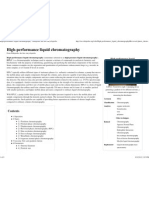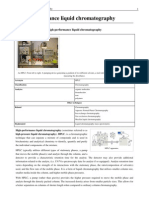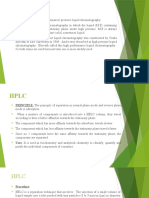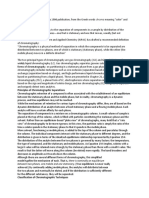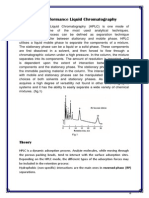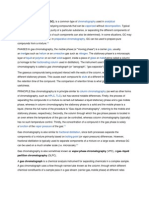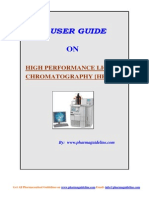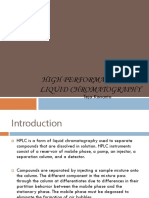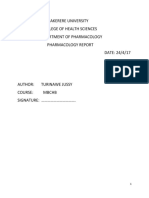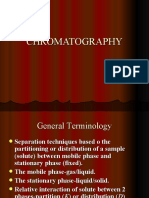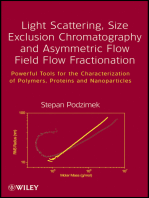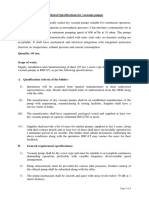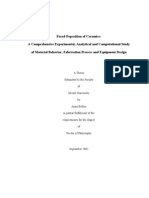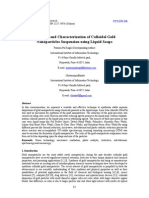Lite TP Gas Chromatography
Lite TP Gas Chromatography
Uploaded by
Antonio FrianCopyright:
Available Formats
Lite TP Gas Chromatography
Lite TP Gas Chromatography
Uploaded by
Antonio FrianCopyright
Available Formats
Share this document
Did you find this document useful?
Is this content inappropriate?
Copyright:
Available Formats
Lite TP Gas Chromatography
Lite TP Gas Chromatography
Uploaded by
Antonio FrianCopyright:
Available Formats
Gas chromatography (GC), is a common type of chromatography used in analytical chemistry for separating and analyzing compounds that
can be vaporized without decomposition. Typical uses of GC include testing the purity of a particular substance, or separating the different components of a mixture (the relative amounts of such components can also be determined). In some situations, GC may help in identifying a compound. In preparative chromatography, GC can be used to prepare pure compounds from a mixture. In gas chromatography, the mobile phase (or "moving phase") is a carrier gas, usually an inert gas such as helium or an unreactive gas such as nitrogen. The stationary phase is a microscopic layer of liquid or polymer on an inert solid support, inside a piece of glass or metal tubing called a column (an homage to the fractionating column used in distillation). The instrument used to perform gas chromatography is called a gas chromatograph (or "aerograph", "gas separator"). The gaseous compounds being analyzed interact with the walls of the column, which is coated with different stationary phases. This causes each compound to elute at a different time, known as the retention time of the compound. The comparison of retention times is what gives GC its analytical usefulness. Gas chromatography is in principle similar to column chromatography (as well as other forms of chromatography, such as HPLC, TLC), but has several notable differences. Firstly, the process of separating the compounds in a mixture is carried out between a liquid stationary phase and a gas mobile phase, whereas in column chromatography the stationary phase is a solid and the mobile phase is a liquid. (Hence the full name of the procedure is "Gasliquid chromatography", referring to the mobile and stationary phases, respectively.) Secondly, the column through which the gas phase passes is located in an oven where the temperature of the gas can be controlled, whereas column chromatography (typically) has no such temperature control. Thirdly, the concentration of a compound in the gas phase is solely a function of the vapor pressure of the gas. Gas chromatography is also similar to fractional distillation, since both processes separate the components of a mixture primarily based on boiling point (or vapor pressure) differences. However, fractional distillation is typically used to separate components of a mixture on a large scale, whereas GC can be used on a much smaller scale (i.e. microscale). http://en.wikipedia.org/wiki/Gas_chromatography
Jenis HPLC
Terdapat 4 jenis utama teknik HPLC, yaitu jenis HPLC fase normal [Normal-Phase Chromatography (NP)], jenis HPLC fase terbalik [Reversed-Phase HPLC ( RP HPLC, RPLC)], jenis HPLC penukar Ion [ Ion-Exchange Chromatography (IEC)] dan terakhir jenis HPLC Size-Exclusion Chromatography (SEC). Normal-Phase Chromatography (NP) Normal phase HPLC (NP HPLC) merupakan metode yaang mengeksplorasi perbedaan kepolaran antara analit dalam campuran dengan fase diam. semakin kuat interaksi fase diam
dengan analit, semakin lama retensi analit. Seperti halnya teknik kromatografi cair, pemisahan NP HPLC adalah proses kompetisi. Molekul analit bersaing melakukan adsorpsi dengan molekul fase gerak pada permukaan fase diam. Semakin kuat fase gerak berinteraksi dengan fase diam, maka semakin rendah interaksi antara fase diam dengan analit, dan dengan demikian semakin rendah retensi analit. Fase gerak NP HPLC didasarkan pada pelarut nonpolar (seperti heksana, heptana, dll) dengan sedikit penambahan senyawa polar. Senyawa polar yang biasa digunakan adalah alkohol (metanol, etanol, atau isopropanol). Variasi konsentrasi senyawa polar pada fase gerak dimaksudkan untuk mengontrol retensi analit dalam kolom. Karena kepolarannya yang dominan, penambahan senyawa polar ke dalam fase gerak relatif sedikit, meskipun hanya 1 %v/v variasi senyawa polar pada fase gerak biasanya menghasilkan perubahan retensi analit yang signifikan. Bahan yang digunakan pada fase diam dalam normal phase HPLC biasanya berpori oksida seperti silika (SiO2) atau alumina (Al2O3). Permukaan fase diam ditutupi dengan gugus OH, yang membuat permukaan menjadi sangat polar. Retensi analit pada permukaan semacam ini sangat sensitif terhadap variasi komposisi fase gerak. Modifikasi kimiawi fase diam juga dapat digunakan dalam HPLC fase normal. Trimethoxy glycidoxypropyl silanes (nama umum: diol-fase) adalah bahan dengan polaritas permukaan lebih rendah yang digunakan untuk memodifikasi silika. Kepadatan permukaan Kelompok OH pada fase diol adalah pada tingkat 3-4mol/m2, sedangkan pada silika silanols kepadatan permukaannya adalah pada tingkat 8mol/m2. Dengan menggunakan fase diam jenis diol dan pengubah polaritas eluen [ester (etil asetat) bukan dari alkohol] memungkinkan untuk meningkatkan pemisahan analit dan meningkatkan reproduktifitas dibandingkan dengan menggunakan silika. http://sanagory.blogspot.com/2012/02/jenis-hplc.html The opposite of normal phase, or Reversed Phase Chromatography, results from the adsorption of hydrophobic molecules onto a hydrophobic solid support in a polar mobile phase. Decreasing the mobile phase polarity by using organic solvents reduces the hydrophobic interaction between the solute and the solid support resulting in de-sorption. The more hydrophobic the molecule the more avidly it will adsorb onto the solid support. This requires a higher concentration of organic solvent to promote de-sorption. Reversed phase chromatography is another very powerful technique and it is effective for the separation of a very wide range of molecules. However, at process scale it is not typically used for proteins, due to the presence of the organic solvent which denatures many proteins and destroys their biological activity. Reversed phase chromatography is used very frequently as an analytical technique and there are many different stationary phases available for method optimization. http://www.separations.eu.tosohbioscience.com/ServiceSupport/TechSupport/ResourceCente r/PrinciplesofChromatography/ReversedPhase/ Ion Exchange Chromatography The most popular method for the purification of proteins and other charged molecules is ion exchange chromatography. In cation exchange chromatography positively charged molecules are attracted to a negatively charged solid support. Conversely, in anion exchange chromatography, negatively charged molecules are attracted to a positively charged solid support.
Mechanism To optimize binding of all charged molecules, the mobile phase is generally a low to medium conductivity (i.e., low to medium salt concentration) solution. The adsorption of the molecules to the solid support is driven by the ionic interaction between the oppositely charged ionic groups in the sample molecule and in the functional ligand on the support. The strength of the interaction is determined by the number and location of the charges on the molecule and on the functional group. By increasing the salt concentration (generally by using a linear salt gradient) the molecules with the weakest ionic interactions start to elute from the column first. Molecules that have a stronger ionic interaction require a higher salt concentration and elute later in the gradient. The binding capacities of ion exchange resins are generally quite high. This is of major importance in process scale chromatography, but is not critical for analytical scale separations. Varying pH Many chromatographers also use changes in pH to affect a separation. In cation exchange chromatography, raising the pH of the mobile phase buffer will cause the molecule to become less protonated and hence less positively charged. The result is that the protein no longer can form a ionic interaction with the negatively charged solid support, which ultimately results in the molecule to elute from the column. In anion exchange chromatography, lowering the pH of the mobile phase buffer will cause the molecule to become more protonated and hence more positively (and less negatively) charged. The result is that the protein no longer can form a ionic interaction with the positively charged solid support which causes the molecule to elute from the column. http://www.separations.us.tosohbioscience.com/ServiceSupport/TechSupport/ResourceCenter /PrinciplesofChromatography/IonExchange Size Exclusion Chromatography Size Exclusion Chromatography (SEC) is the separation technique based on the molecular size of the components. Separation is achieved by the differential exclusion from the pores of the packing material, of the sample molecules as they pass through a bed of porous particles. The principle feature of SEC is its gentle non-adsorptive interaction with the sample, enabling high retention of biomolecular activity. http://www.separations.us.tosohbioscience.com/ServiceSupport/TechSupport/ResourceCenter /PrinciplesofChromatography/SizeExclusion/ The factors that affect retention time depends on the separation mode that you are using. If you're using a polar stationary phase (like bare silica) then you are probably running Normal Phase or HILIC. In that case your retention is going to be based largely on the polarity of your compound. More hydrophilic (polar) compounds will stay on the column longer and have a larger retention time. Reversed phase is the opposite (hence the name). The stationary phase is hydrophobic, so hydrophilic compounds spend less time on the column and come out sooner. If you're looking to separate based on molar mass then SEC is your best bet, but it doesn't have great resolution, especially for small molecules (less than 2,000-4000 Amu). http://answers.yahoo.com/question/index?qid=20090314045116AADs2lD
2.2
APLIKASI HPLC
Beberapa aplikasi HPLC dalam kehidupan : HPLC dengan prinsip kromatografi banyak digunakan pada industri farmasi dan pestisida. Zat- zat dengan kepolaran berbeda yaitu antara sedikit polar sampai polar dapat dipisahkan dengan HPLC berdasarkan partisi cair-cair. Asam-asam nukleat dapat dipisahkan dengan kolom penukar ion yang dikombinasikan dengan kolom butiran berlapis zat berpori Morfin, heroin dan semacamnya telah dapat dipisahkan dengan rezin Zipax-SAX. Dapat memisahkan vitamin-vitamin yang larut dalam air.
2.2.1
Analisis Anion Nitrat (NO3-)
Nitrat sebagai hasil proses alami atau industri akan bisa memasuki bahan alam atau bahan industri seperti air yang sangat dibutuhkan manusia atau untuk kebutuhan industri. Kandungan dalam jumlah tertentu akan sangat mempengaruhi kualitas air tersebut. Untuk itu diperlukan suatu metode analisis yang teruji untuk mengukur kandungan nitrtat tersebut. Dengan menggunakan HPLC sebagai instrumen analisis dan dengan pengembangan metode dapat diketahui validitas penggunaan HPLC untuk analisis anion nitrat. Dari beberapa model pemutakhiran HPLC diketahui metode analisis HPLC dengan kolom IC Pak Anion serta eluen campuran Na-Borat glukonat : Butanol : Asetonitril (1:1:10) dan detektor Konduktivitas dapat menganalisis ion nitrat dalam air tangki reaktor, dengan batas deteksi 3,661 ppm dan sensitivitas 0,01 ppm serta uji recovery 110,41+ 1,59%.
2.2.2
Analisis Vitamin C
Metode HPLC juga dapat digunakan sebagai dasar dari analisis vitamin C, yakni dalam menentukan susunan kimianya.Susunan kimia vitamin C ditemukan pada tahun 1933 oleh ilmuwan Inggris dan Swiss. Isolasi asam askorbat mula-mula ditemukan oleh King dari USA dan Szent-Gyorgy dari Hungaria. Vitamin ini mempunyai dua bentuk, yaitu bentuk oksidasi (bentuk dehydro) dan bentuk reduksi. Kedua bentuk ini mempunyai aktivitas biologi. Dalam makanan bentuk reduksi yang terbanyak. Banyak dehydro dapat terus teroksidasi menjadi diketogulonic acid yang inaktif.
2.2.4
Pengukuran Tingkat Kematangan Buah Manggis
Mutu buah-buahan segar saat ini umumnva masih dievalusi secara manual yang menggunakan tanda-tanda visual seperti warna kulit. Hasil evaluasi visual yang hanya menilai sifat fisik bagian luar ini tidak selalu mencerminkan tingkat kematangan dan kerusakan bagian dalam buah. Bila ingin menentukan mutu bagian dalam buah harus digunakan cara kimia basah (HPLC) yang bersifat merusak. Dalam menanggulangi masalah ini perlu dilakukan suatu penelitian mengenai teknologi tertentu yang dapat dimanfaatkan untuk menentukan mutu bagian dalam buah-buahan secara tidak merusak. http://rafizanisa.blogspot.com/2009/12/analisis-hplc-dan-aplikasinya.html
Aplikasi kromatografi gas Kromatografi gas telah digunakan pada sejumlah besar senyawa-senyawa dalam berbagai bidang. Dalam senyawa organic dan anorganik, senyawa logam, karena persyaratan yang digunakan adalah tekanan uap yang cocok pada suhu saat analisa dilakukan. Berikut akan kita lihat beberapa kegunaan kromatografi gas pada bidang-bidangmya adalah : a. Polusi udara Kromatografi gas merupakan alat yang penting karena daya pemisahan yang digabungkan dengan daya sensitivitas dan pemilihan detector GLC menjadi alat yang ideal untuk menentukan banyak senyawa yang terdapat dalam udara yang kotor, KGCdipakai untuk menetukan Alkil-Alkil Timbal, Hidrokarbon, aldehid, keton SO , H S, dan beberapa oksida dari nitrogen dll Obat Diklinik kromatografi gas menjadi alat untuk menangani senyawa-senyawa dalam klinik seperti : asam-asam amino, karbohidrat, CO , dan O dalam darah, asam-asam lemak dan turunannya, trigliserida-trigliserida, plasma steroid, barbiturate, dan vitamin Bahan-bahan pelapis Digunakan untuk menganalisa polimer-polimer setelah dipirolisa, karet dan resinresin sintesis Minyak atsiri Digunakan untuk pengujian kulaitas terhadap minyak permen, jeruk sitrat, dll Bahan makanan Digunakan dengan TLC dan kolom-kolom, untuk mempelajari pemalsuanatau pencampuran, kontaminasi dan pembungkusan dengan plastic pada bahan makanan, juga dapat dipakai unutk menguji jus, aspirin, kopi dll Perminyakan Kromatografi gas dapat digunakan unutk memisahkan dan mengidentifikasi hasilhasildari gas-gas hidrokarbon yang ringan http://ariffadholi.blogspot.com/2009/10/oleh-najiullah-2007-kromatografi-gasi.html
b.
c.
d. e.
f.
You might also like
- CHROMATOGRAPHYDocument9 pagesCHROMATOGRAPHYmaggyebanksNo ratings yet
- Classification of Chromatographic TechniquesDocument8 pagesClassification of Chromatographic TechniquesArfa AshrafNo ratings yet
- Chemical Separation and Chromatographic Methods Chem 458Document37 pagesChemical Separation and Chromatographic Methods Chem 458Krishanarju VenkatesanNo ratings yet
- RP HPLCDocument9 pagesRP HPLCGoutam GhoshNo ratings yet
- HPLCDocument9 pagesHPLCEssar MuhthaniNo ratings yet
- Liquid Chromatography: General SchemeDocument5 pagesLiquid Chromatography: General SchemeDivya BajpaiNo ratings yet
- Chemical SafetyDocument36 pagesChemical SafetySidd MadniNo ratings yet
- HPLC LectureDocument17 pagesHPLC LectureMani JeeNo ratings yet
- High Performance Liquid ChromatographyDocument15 pagesHigh Performance Liquid ChromatographyFaran Faseesa Ismail0% (1)
- HPLCDocument8 pagesHPLCShaffan MohdNo ratings yet
- The Term Chromatography in A 1906 PublicationDocument4 pagesThe Term Chromatography in A 1906 PublicationMayaNo ratings yet
- High Performance Liquid ChromatographyDocument11 pagesHigh Performance Liquid ChromatographyPrincess AleenaNo ratings yet
- ChE 133 - Case StudyDocument10 pagesChE 133 - Case StudyRiscia NaduraNo ratings yet
- Atomic Absorption SpectrosDocument2 pagesAtomic Absorption SpectrosSirTonz100% (1)
- Types of ChromatographyDocument12 pagesTypes of ChromatographyDurvva GandhiNo ratings yet
- High Performance Liquid Chromatography (HPLC) : Presenter: Nandit P BDocument39 pagesHigh Performance Liquid Chromatography (HPLC) : Presenter: Nandit P BNandit BanawalikarNo ratings yet
- Chromatography Unit-5 BotanyDocument4 pagesChromatography Unit-5 Botanyharshkumargi147No ratings yet
- CHROMATOGRAPHYDocument9 pagesCHROMATOGRAPHYKarthi Keyan KanagarajNo ratings yet
- CHROMATOGRAPHY chapter 2Document12 pagesCHROMATOGRAPHY chapter 2gullmaryam123No ratings yet
- A User Guide: High Performance Liquid Chromatography (HPLC)Document54 pagesA User Guide: High Performance Liquid Chromatography (HPLC)Marcelinus AlfasisuryaNo ratings yet
- HPLCDocument4 pagesHPLCAlbert BohrNo ratings yet
- Chembio 2 - Week 5Document4 pagesChembio 2 - Week 5EJNo ratings yet
- AminoDocument28 pagesAminoqurrota ainynNo ratings yet
- Chromatography: Chromatography From Greek Chroma Which Means "Color" and Graphein "ToDocument3 pagesChromatography: Chromatography From Greek Chroma Which Means "Color" and Graphein "ToSana BatoolNo ratings yet
- 11082924385258Document83 pages11082924385258Oyelami TheophilusNo ratings yet
- Chromatography TechniquesDocument9 pagesChromatography TechniquesAyush GuptaNo ratings yet
- Separation TechniquesDocument9 pagesSeparation TechniquesBobbo KabirNo ratings yet
- HPLC User GuideDocument54 pagesHPLC User GuidesdrtfgNo ratings yet
- Chromatography: What Is It??Document15 pagesChromatography: What Is It??SP ManjunathNo ratings yet
- FST-601 - F00 - BASIC PRINCIPLES OF CHROMATOGRAPHY-7th WeekDocument32 pagesFST-601 - F00 - BASIC PRINCIPLES OF CHROMATOGRAPHY-7th WeekKashif MehmoodNo ratings yet
- High Performance Liquid ChromatographyDocument22 pagesHigh Performance Liquid ChromatographyHabibaqNo ratings yet
- Chromatography: Theory & PracticeDocument29 pagesChromatography: Theory & PracticeMaame Ama FrempongNo ratings yet
- Chromatographic Biochemistry Analytical ChemistryDocument8 pagesChromatographic Biochemistry Analytical ChemistryDeepanshi BansalNo ratings yet
- BSC 821 CH 2Document44 pagesBSC 821 CH 2parasharaarna2No ratings yet
- High Performance Liquid ChromatographyDocument22 pagesHigh Performance Liquid ChromatographySyukri DaimonNo ratings yet
- High-Performance Liquid Chromatography (HPLC Formerly Referred ToDocument21 pagesHigh-Performance Liquid Chromatography (HPLC Formerly Referred ToKhagesh JoshNo ratings yet
- CHROMATOGRAPHYDocument1 pageCHROMATOGRAPHYLopez Jaramillo AlejandroNo ratings yet
- Chromatography and Its TypesDocument3 pagesChromatography and Its Typesusman umer umerNo ratings yet
- High Performance Liquid ChromatographyDocument22 pagesHigh Performance Liquid ChromatographyRenita NovianiNo ratings yet
- Typesof ChromatographyDocument31 pagesTypesof ChromatographyDua WritesNo ratings yet
- High Performance Liquid Chromatography VERY GOODDocument22 pagesHigh Performance Liquid Chromatography VERY GOODDewi SeptianiNo ratings yet
- A Review On High Performance Liquid Chromatography HPLCDocument19 pagesA Review On High Performance Liquid Chromatography HPLCValery FujitaNo ratings yet
- A User Guide HPLCDocument54 pagesA User Guide HPLCjeyapragash RamadassNo ratings yet
- Exclusion, Molecular Sieving) - The Operating of These Processes, Coupled With The MovementDocument7 pagesExclusion, Molecular Sieving) - The Operating of These Processes, Coupled With The MovementanaNo ratings yet
- Makerere University College of Health Sciences Department of Pharmacology Pharmacology Report DATE: 24/4/17Document10 pagesMakerere University College of Health Sciences Department of Pharmacology Pharmacology Report DATE: 24/4/17mug ashNo ratings yet
- hplc điều chế tiếng anhDocument5 pageshplc điều chế tiếng anhmyngan005xtdlNo ratings yet
- Subdivision of Chromatography InstrumentDocument6 pagesSubdivision of Chromatography Instrumentmigom7md1No ratings yet
- Assignment Analytical Chemistery BY Muhammad Pervaiz Roll Number 1039 Bs Chemistry 4 (M)Document5 pagesAssignment Analytical Chemistery BY Muhammad Pervaiz Roll Number 1039 Bs Chemistry 4 (M)Open UserNo ratings yet
- SeparationsDocument3 pagesSeparationsalexpharmNo ratings yet
- ChromatographyDocument31 pagesChromatographySurya Kanta SenNo ratings yet
- New Microsoft Office Word DocumentDocument13 pagesNew Microsoft Office Word DocumentDanish AmanNo ratings yet
- Chromatography 1Document47 pagesChromatography 1Sudeeksha RavikotiNo ratings yet
- Chromatography 105545Document11 pagesChromatography 105545eferogheneefelulu19No ratings yet
- CHROMATOGRAPHY2Document33 pagesCHROMATOGRAPHY2Nurfatihah ZulkifliNo ratings yet
- Analytical Characterization of BiotherapeuticsFrom EverandAnalytical Characterization of BiotherapeuticsJennie R. LillNo ratings yet
- Physico-Chemistry of Solid-Gas Interfaces: Concepts and Methodology for Gas Sensor DevelopmentFrom EverandPhysico-Chemistry of Solid-Gas Interfaces: Concepts and Methodology for Gas Sensor DevelopmentNo ratings yet
- Light Scattering, Size Exclusion Chromatography and Asymmetric Flow Field Flow Fractionation: Powerful Tools for the Characterization of Polymers, Proteins and NanoparticlesFrom EverandLight Scattering, Size Exclusion Chromatography and Asymmetric Flow Field Flow Fractionation: Powerful Tools for the Characterization of Polymers, Proteins and NanoparticlesNo ratings yet
- PH and Buffer System - NotesDocument29 pagesPH and Buffer System - Noteskatherine morenoNo ratings yet
- Gibbsite Solubility and ThermodynamicDocument8 pagesGibbsite Solubility and ThermodynamicSwadhin HassanNo ratings yet
- Bio ComputingDocument3 pagesBio ComputingRadhika MalpaniNo ratings yet
- On The Flow of A Compressible-Proceedings of The Institution of Mechanical EngineersDocument11 pagesOn The Flow of A Compressible-Proceedings of The Institution of Mechanical EngineersmsreerajvarmaNo ratings yet
- Rheological Properties of Food: A Review: Ramya VDocument8 pagesRheological Properties of Food: A Review: Ramya Viaset123No ratings yet
- 26 Heat Exchanger Effectiveness, NTU PDFDocument13 pages26 Heat Exchanger Effectiveness, NTU PDFananth2012No ratings yet
- Remove & Install RadiatorDocument4 pagesRemove & Install RadiatorIndah Widya PutriNo ratings yet
- Desorption of Dye From Activated Carbon BedsDocument7 pagesDesorption of Dye From Activated Carbon BedsTejo PaijoNo ratings yet
- Fly AshDocument11 pagesFly AshsaratNo ratings yet
- Assignment 1 PDFDocument1 pageAssignment 1 PDFNur AqilahNo ratings yet
- Vacuum Pump SopDocument4 pagesVacuum Pump SopHarsh KhatriNo ratings yet
- Simulated Service Test ManualDocument12 pagesSimulated Service Test ManualFerryNo ratings yet
- Pressure Vessel DesignDocument23 pagesPressure Vessel DesignKevinNo ratings yet
- May 2020 Chem Engg Refresher 3Document2 pagesMay 2020 Chem Engg Refresher 3Master JaguarNo ratings yet
- 8474l 000 JSD 2220 001 1 Cold Service InsulationDocument51 pages8474l 000 JSD 2220 001 1 Cold Service InsulationlebienthuyNo ratings yet
- What Are Different Types of Microscopic Techniques That Are Available For Investigating The Microstructure of MaterialsDocument6 pagesWhat Are Different Types of Microscopic Techniques That Are Available For Investigating The Microstructure of Materialsmuhammadahmadjura60No ratings yet
- Using High Performance Heat Tracing Systems To Address Problem Areas in Sulfur Recovery UnitsDocument7 pagesUsing High Performance Heat Tracing Systems To Address Problem Areas in Sulfur Recovery UnitsHsein WangNo ratings yet
- Understanding Typhoon NotesDocument1 pageUnderstanding Typhoon NotesMARISTELA MACARANASNo ratings yet
- Creusabro 4800: IndusteelDocument6 pagesCreusabro 4800: IndusteelLuân LêNo ratings yet
- Betrachtung Der FDM Extrusion - Anna Bellini 2002Document319 pagesBetrachtung Der FDM Extrusion - Anna Bellini 2002Traumflug100% (2)
- (82-87) Synthesis and Characterization of Colloidal Gold Nano Particles Suspension Using Liquid SoapsDocument7 pages(82-87) Synthesis and Characterization of Colloidal Gold Nano Particles Suspension Using Liquid SoapsAlexander DeckerNo ratings yet
- Vernacular Architecture CoolingDocument12 pagesVernacular Architecture CoolingMeg D ReidNo ratings yet
- Half Cell Electrical Potential TestDocument9 pagesHalf Cell Electrical Potential TestpscNo ratings yet
- Polymer CharacterizationDocument29 pagesPolymer CharacterizationjeLIMBOSTARRNo ratings yet
- Tunnel Effect &AFM-STMDocument21 pagesTunnel Effect &AFM-STMAgnivesh SharmaNo ratings yet
- 03 Drop Dynamics in The Inkjet PrintingDocument8 pages03 Drop Dynamics in The Inkjet PrintingVatsalya TandonNo ratings yet
- Surface 8Document31 pagesSurface 8Narkedamilli Tulasi RadhaNo ratings yet
- Memoria de Cálculo CorreasDocument7 pagesMemoria de Cálculo CorreasAbner Ramos ApazaNo ratings yet
- Darshi DhaliwalDocument40 pagesDarshi DhaliwalSamiYousifNo ratings yet
- Mechanisms of Plastic Deformation in MetalsDocument12 pagesMechanisms of Plastic Deformation in Metalsjimaerospace05No ratings yet



